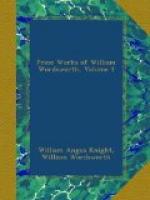It was Mr. Theed, the sculptor, who informed us of the pine tree being the gift of Sir George Beaumont. This incident occurred within a few minutes after our walking up the Pincian Hill. And this was the very first observation Mr. W. made at Rome.
It was a remark justly made on the Memorials of the Swiss Journey in 1820, that Mr. W. left unnoticed the great objects which have given rise to innumerable common-place verses and huge piles of bad prose, and which every body talks about, while he dwelt on impressions peculiar to himself. As a reproach, nothing can be more idle and unmeaning. I expected it would be so with these latter poems, and so I found it. There are not more than two others which bring anything to my mind.
The most important of these is the ‘Cuckoo at Laverna.’ I recollect perfectly well that I heard the cuckoo at Laverna twice before he heard it; and that it absolutely fretted him that my ear was first favoured; and that he exclaimed with delight, ‘I hear it! I hear it!’ It was at Laverna, too, that he led me to expect that he had found a subject on which he would write; and that was the love which birds bore to St. Francis. He repeated to me a short time afterwards a few lines, which I do not recollect among those he has written on St. Francis in this poem. On the journey, one night only I heard him in bed composing verses, and on the following day I offered to be his amanuensis; but I was not patient enough, I fear, and he did not employ me a second time. He made inquiries for St. Francis’s biography, as if he would dub him his Leib-heiliger (body-saint), as Goethe (saying that every one must have one) declared St. Philip Neri to be his.
The painter monk at Camaldoli also interested him, but he heard my account only in addition to a very poor exhibition of professional talent; but he would not allow the pictures to be so very poor, as every nun ought to be beautiful when she takes the veil.




